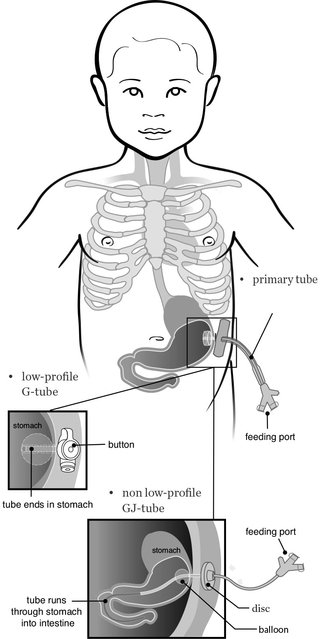Primary Feeding Tube Conversion
A feeding tube is placed through the abdominal wall to allow feeding directly into the stomach or intestines. A tube delivering nutrition into the stomach is a gastrostomy tube, or G tube; a tube delivering nutrition into the intestines is a gastrojejunostomy tube, or GJ tube.
The first tube your child receives is called the primary tube. About 12 weeks after the primary tube is placed, the stoma or tract, which is the hole the tube is in, leading from the skin to the stomach, will have healed, and we will change the type of tube. This is called a tube conversion.
How is tube conversion performed?
The healthcare provider will cut the portion of primary tube that is outside of the body, and the retention disc inside the stomach, which holds the tube in place, will collapse. The doctor will then pull out the remainder of the tube.
The provider will measure the length of the stoma and place one of the following tubes:
- A low-profile button, which sits nearly flat with the skin. This is a gastrostomy tube. You will hear us call this type of tube a low-profile G tube, a G button or a GJ button.
- A non-low-profile tube (can be a G tube or GJ tube). This type of tube extends a distance from the skin and has an external disc to secure it in position. This is not a low-profile tube; it hangs several inches from the skin.
Primary feeding tube conversion

Will my child be awake for the procedure?
We will use IV sedation or anesthesia, depending on your child’s health conditions. Subsequent tube changes will occur every three to six months and do not require sedation or anesthesia in most cases.
How long does the procedure take?
Approximately 20 to 30 minutes.
What are the risks of the procedure?
The procedure is considered low risk.
However, potential complications include:
- Bleeding from the skin (usually minimal)
- Infection of the surrounding skin or abdominal wall
- Bowel perforation with GJ-tube placement (rare)
Will my child have pain after the tube is changed?
After the procedure, the site may be tender. You may give your child over-the-counter pain medication.
What can I expect after the procedure?
In most cases, your child can go home immediately after the tube conversion and you can begin to use the tube right away — you don’t have to wait. The site might be tender for a day or two, and you may see a few drops of blood around the site
How will I know how to care for the tube?
We will schedule you for an educational class on the same day as the tube conversion. The class is free and lasts approximately one hour. A nurse or other healthcare professional will teach you how to administer feeds, how to troubleshoot and how to use the pump. If a class isn’t available on that day, a nurse from radiology will teach you how to care for the tube.
When can my child bathe after the procedure?
Your child may take a bath or shower in 24 hours.
Are there any activity restrictions?
There are no specific activity restrictions.
However, your child shouldn’t participate in contact sports or rough playing that might result in a pull to the tube.
Contact us immediately if your child experiences any of the following:
- Tube becomes dislodged or damaged
- Bleeding or drainage such as pus from the site
- Redness or swelling at the site
- Fever higher than 101° Fahrenheit
- Pain that isn’t helped by over-the-counter pain medication
Call your CHOP team with any questions or concerns.
Interventional Radiology (IR)
8:00am-4:30pm, Monday-Friday
215-590-7000
Every day after 4:30 pm, weekends and holidays
215-590-1000, ask the hospital operator for the Interventional Radiologist on-call